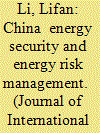| Srl | Item |
| 1 |
ID:
142919


|
|
|
|
|
| Summary/Abstract |
China is facing serious energy security issues. In recent years, China's energy structure has undergone major adjustments, while qualitative changes have taken place in the form of energy security. This raises a new question for China's political, diplomatic, military, technological, and industrial structures: How to safeguard China's energy security? This paper is intended to analyze approaches to energy imports and bottlenecks of energy development, and proposes that international cooperation, development of new energy sources and improvement in energy efficiency will contribute to resolving the energy crisis, and puts forward policy proposals to achieve China's strategy of peaceful development.
|
|
|
|
|
|
|
|
|
|
|
|
|
|
|
|
| 2 |
ID:
111432


|
|
|
|
|
| Publication |
2012.
|
| Summary/Abstract |
A practical mathematical programming model for the strategic fuel diversification problem is presented. The model is designed to consider the tradeoffs between the expected costs of investments in capacity, operating and maintenance costs, average fuel costs, and the variability of fuel costs. In addition, the model is designed to take the load curve into account at a high degree of resolution, while keeping the computational burden at a practical level.
The model is illustrated with a case study for Indiana's power generation system. The model reveals that an effective means of reducing the volatility of the system-level fuel costs is through the reduction of dependence on coal-fired generation with an attendant shift towards nuclear generation. Model results indicate that about a 25% reduction in the standard deviation of the generation costs can be achieved with about a 20-25% increase in average fuel costs. Scenarios that incorporate costs for carbon dioxide emissions or a moratorium on nuclear capacity additions are also presented.
|
|
|
|
|
|
|
|
|
|
|
|
|
|
|
|